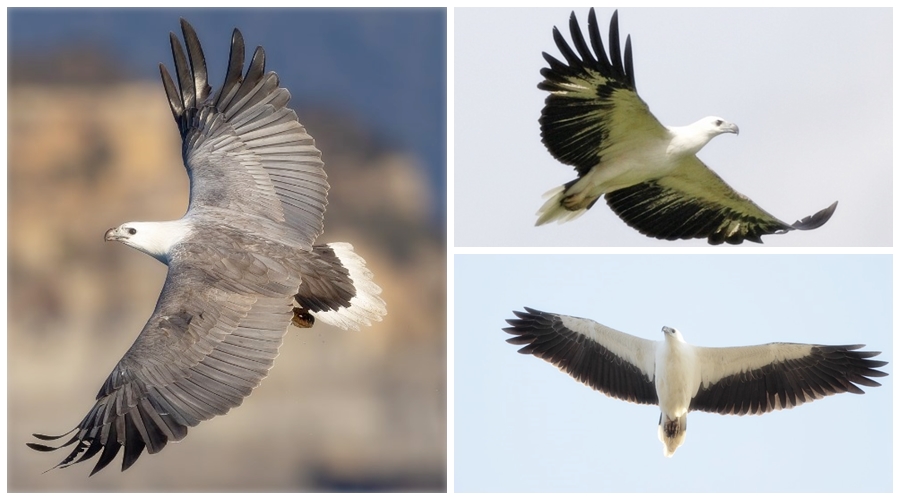Behavior & Habitats: The white-bellied sea eagle (Haliaeetus leucogaster), which is a large, huge taloned sea eagle with a graceful flight and attractive grey-white tones, belies the aggressiveness of this large, huge sea eagle. As it spends a considerable amount of time soaring and sailing over and adjacent to surface waters and bays, with a full set of wings upswept, it will either perch on a rock or exposed branch on a prominent tree next to water or it will jump from rock to rock.
There are two pairs of crows that hold the same hunting range year-round. These pairs are permanent and have a few favorite perches where they rest and roost together, as well as duet with one another in the mornings and evenings. There is a slow and powerful rhythm to the wing beats of a bird when it is in flight.

Diet: The sea eagle is an avian predator that normally hunts from its perches or from the air. It is commonly known to dive on fish, snatch them from the surface with its talons with one sweep, or catch tortoises, sea snakes, waterfowl, nestlings from rookeries, and even rabbits on land. Birds also eat carrion at times, landing on the ground to feed on the dead matter.
A few terns and ospreys are occasionally harried by them as well, taking their prey with them. A display pair is one which soars very high and calls constantly to announce its presence, loops a loop, drops fish from a great height, and dives to catch it in mid-flight at the onset of breeding. In the end, it takes all the food and cows that are left so they will die as a result.
Alternative Names: It is also known as the White-breasted Sea-Eagle.
Size: A White-bellied sea eagle measures 760 mm in length for a male and 840 mm for a female.
Identification: There is no difference between the sexes. The wings, the back, and the base of the tail are dark ash-grey, while the broad tip of the tail is white. The head, neck, and underparts of the animal, including the undertail, are all white, often spotted with faint dark gray shaft streaks. There is a brown color to the eyes.
The bill is blue-grey with a black tip; the cere is grey in color. The feet and toes of the animal are off-white in color; the claws are black in color. Maturity: First-year birds have all upper parts which are light brown with pale buff feather tips; the tail is light brown with a white base; the breast is brown with buff edges to the feathers; and the belly is brown with buff patches. The majority of the birds in their second year are slate-brown on top and light brown underneath, with almost no white on their heads and tails. During the third or fourth year of a person’s life, they acquire their full adult plumage. The Downy young are in white color.
Call: White-bellied sea eagles display a loud clanging or a cank-cank-cank, goose-like, call that is sustained, and the heads of the birds are pointing skywards as the birds perform sustained duets. In the breeding season, the bird is more vocal than during other times of the year.
Nest and Breeds: Breeding and nesting take place between the months of May and October. A territory may contain anywhere from one to several nests, and each nest is used every year, with both sexes contributing to the construction and adding to the nests until the nests become enormous.
A nest is a huge structure made of sticks, often up to 4 meters deep, at a height of 30 meters or more above ground, that is used annually for a long period of time. The nest can also be found in smaller trees in swamps, on coastal cliffs, on the ground, or on rocks on islands without trees that are located in inland swamps. There is a layer of green leaves inside the nest, which is added throughout the breeding period.
Eggs & Incubation: There are two eggs laid by the white-bellied sea eagle; they are oval and about 71 x 53 mm in size. The female does most of the incubation and brooding during the day while the male relieves for periods of time during the day. Despite the fact that eggs are laid a few days apart, the incubation period begins as soon as the first egg is laid, giving the first one to hatch a head start on the others.
It is the female who feeds her young using food brought by the male and she broods and incubates the young without any interruption from the male except for a short period of time (about ten percent of the time). Females are mainly responsible for the incubation period, which lasts about six weeks. Nine to ten weeks are required for the young to fledge.
Distribution: Sea eagles with white bellies are widely distributed throughout coastal Australia, along coastlines, and in large lowland rivers and lakes. There are also inland lakes and waterways along the Murray River and its larger tributaries that belong to the area. A range of this bird can be found from India and southern China to Indonesia and New Guinea. There is a tendency for it to be a sedentary or nomadic bird.
Races: No races. Read More – The Indian Birds of Prey
